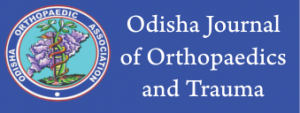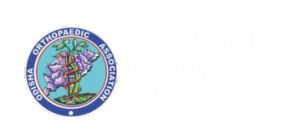Low-cost vacuum assisted closure therapy for extensive musculoskeletal trauma and infection: Outcomes, efficacy and limitations
Vol 01 | January 2020 | page: 21-25 | Anurag Singh, Damodar Panda, Jitendra Mishra, Aniruddh Dash
DOI- 10.13107/ojot.2020.v41i01.007
Authors: Anurag Singh [1], Damodar Panda [1], Jitendra Mishra [1], Aniruddh Dash [1]
[1] Department of Orthopaedics, IMS & SUM Hospital, Bhubaneswar, Odisha India.
Address of Correspondence
Dr. Anurag Singh,
IMS & SUM Hospital, Bhubaneswar, Odisha India.
E-mail: goanurag007@gmail.com
Abstract
Introduction: High-energy musculoskeletal trauma with extensive soft tissue loss is difficult to treat and underlying fracture makes it more cumbersome. This prolongs hospitalization and regular conventional dressings increase socio-economic burden. Vacuum assisted closure (VAC) was developed to prepare wound for early definitive management. It acts by decreasing edema, exudates, bacterial counts and promotes granulation tissue formation, neovascularization, approximates wound edges.
Aim: To evaluate outcomes, efficacy and limitations of low-cost VAC for management of extensive soft tissue loss and infected wounds.
Materials and Methods: This study was conducted in Dept. Of Orthopedics of a tertiary care hospital from December 2018 to July 2019 on 53 patients, either with extensive soft tissue injury following acute trauma or those with infected-necrotic wound. Forty two patients had acute trauma history while remaining 11 had infected non healing wound. Cultures were sent pre and post VAC application and antibiotic coverage was administered. Low cost VAC was applied after debridement and changed after every 3 – 4 days.
Results: Forty eight cases treated with low-cost VAC were ready for skin graft/flap/secondary suture after 1 to 3 cycles (4 to 12 days) of therapy. Another two cases developed spontaneous re-epithelization. The wound infection was controlled in 70% of the cases. Three patients did not achieve desired result due to limitations of the procedure.
Conclusion: Low-cost VAC has proved to be effective while being substantially cheaper (1/16th of conventional VAC). Its role is limited when the depth of wound is far greater than its length.
Keywords: Low cost VAC, Vacuum assisted closure, wound management, Negative pressure wound therapy, Soft tissue loss, Compound fracture.
References
1. Morykwas, M. J., L. C. Argenta, E. I. Shelton-Brown, and W. McGuirt. “Vacuum-Assisted Closure: A New Method for Wound Control and Treatment: Animal Studies and Basic Foundation.” Annals of Plastic Surgery 38, no. 6 (June 1997): 553–62. https://doi.org/10.1097/00000637-199706000-00001.
2. Morykwas, M. J., and L. C. Argenta. “Nonsurgical Modalities to Enhance Healing and Care of Soft Tissue Wounds.” Journal of the Southern Orthopaedic Association 6, no. 4 (1997): 279–88.
3. Morykwas, M. J., L. C. Argenta, E. I. Shelton-Brown, and W. McGuirt. “Vacuum-Assisted Closure: A New Method for Wound Control and Treatment: Animal Studies and Basic Foundation.” Annals of Plastic Surgery 38, no. 6 (June 1997): 553–62. https://doi.org/10.1097/00000637-199706000-00001.
4. Argenta, L. C., and M. J. Morykwas. “Vacuum-Assisted Closure: A New Method for Wound Control and Treatment: Clinical Experience.” Annals of Plastic Surgery 38, no. 6 (June 1997): 563–76; discussion 577.
5. Genecov, D. G., A. M. Schneider, M. J. Morykwas, D. Parker, W. L. White, and L. C. Argenta. “A Controlled Subatmospheric Pressure Dressing Increases the Rate of Skin Graft Donor Site Reepithelialization.” Annals of Plastic Surgery 40, no. 3 (March 1998): 219–25. https://doi.org/10.1097/00000637-199803000-00004.
6. McCallon, S. K., C. A. Knight, J. P. Valiulus, M. W. Cunningham, J. M. McCulloch, and L. P. Farinas. “Vacuum-Assisted Closure versus Saline-Moistened Gauze in the Healing of Postoperative Diabetic Foot Wounds.” Ostomy/Wound Management 46, no. 8 (August 2000): 28–32, 34.
7. Philbeck, T. E., K. T. Whittington, M. H. Millsap, R. B. Briones, D. G. Wight, and W. J. Schroeder. “The Clinical and Cost Effectiveness of Externally Applied Negative Pressure Wound Therapy in the Treatment of Wounds in Home Healthcare Medicare Patients.” Ostomy/Wound Management 45, no. 11 (November 1999): 41–50.
8. Eginton, M. T., K. R. Brown, G. R. Seabrook, J. B. Towne, and R. A. Cambria. “A Prospective Randomized Evaluation of Negative-Pressure Wound Dressings for Diabetic Foot Wounds.” Annals of Vascular Surgery 17, no. 6 (November 2003): 645–49. https://doi.org/10.1007/s10016-003-0065-3.
9. Herscovici, Dolfi, Roy W. Sanders, Julia M. Scaduto, Anthony Infante, and Thomas DiPasquale. “Vacuum-Assisted Wound Closure (VAC Therapy) for the Management of Patients with High-Energy Soft Tissue Injuries.” Journal of Orthopaedic Trauma 17, no. 10 (December 2003): 683–88. https://doi.org/10.1097/00005131-200311000-00004.
10. Song, D. H., Wu, L. C., Lohman, R. F., Gottlieb, L. J., & Franczyk, M. (2003). Vacuum Assisted Closure for the Treatment of Sternal Wounds: The Bridge between Débridement and Definitive Closure. Plastic and Reconstructive Surgery, 111(1), 92–97. doi:10.1097/01.prs.0000037686.14278.6a
11. Mouës, C. M., G. J. C. M. van den Bemd, F. Heule, and S. E. R. Hovius. “Comparing Conventional Gauze Therapy to Vacuum-Assisted Closure Wound Therapy: A Prospective Randomised Trial.” Journal of Plastic, Reconstructive & Aesthetic Surgery: JPRAS 60, no. 6 (2007): 672–81. https://doi.org/10.1016/j.bjps.2006.01.041.
12. Armstrong, David G., Lawrence A. Lavery, and Diabetic Foot Study Consortium. “Negative Pressure Wound Therapy after Partial Diabetic Foot Amputation: A Multicentre, Randomised Controlled Trial.” Lancet (London, England) 366, no. 9498 (November 12, 2005): 1704–10. https://doi.org/10.1016/S0140-6736(05)67695-7.
13. Vuerstaek, J. D. D., Vainas, T., Wuite, J., Nelemans, P., Neumann, M. H. A., & Veraart, J. C. J. M. (2006). State-of-the-art treatment of chronic leg ulcers: A randomized controlled trial comparing vacuum-assisted closure (V.A.C.) with modern wound dressings. Journal of Vascular Surgery, 44(5), 1029–1037. doi:10.1016/j.jvs.2006.07.030
14. Llanos, S., Danilla, S., Barraza, C., Armijo, E., Pi??eros, J. L., Quintas, M., … Calderon, W. (2006). Effectiveness of Negative Pressure Closure in the Integration of Split Thickness Skin Grafts. Annals of Surgery, 244(5), 700–705. doi:10.1097/01.sla.0000217745.56657.e5
15. Vuerstaek, Jeroen D. D., Tryfon Vainas, Jan Wuite, Patty Nelemans, Martino H. A. Neumann, and Joep C. J. M. Veraart. “State-of-the-Art Treatment of Chronic Leg Ulcers: A Randomized Controlled Trial Comparing Vacuum-Assisted Closure (V.A.C.) with Modern Wound Dressings.” Journal of Vascular Surgery 44, no. 5 (November 2006): 1029–37; discussion 1038. https://doi.org/10.1016/j.jvs.2006.07.030.
16. “Tools to Compare the Cost of NPWT with Advanced Wound Care: An Aid to Clinical Decision-Making – Wounds International.” https://www.woundsinternational.com/resources/details/tools-to-compare-the-cost-of-npwt-with-advanced-wound-care-an-aid-to-clinical-decision-making.
17. Eginton, Mark T., Kellie R. Brown, Gary R. Seabrook, Jonathan B. Towne, and Robert A. Cambria. “A Prospective Randomized Evaluation of Negative-Pressure Wound Dressings for Diabetic Foot Wounds.” Annals of Vascular Surgery 17, no. 6 (November 2003): 645–49. https://doi.org/10.1007/s10016-003-0065-3.
18. Isago, Tsukasa, Motohiro Nozaki, Yuji Kikuchi, Takashi Honda, and Hiroaki Nakazawa. “Negative-Pressure Dressings in the Treatment of Pressure Ulcers.” The Journal of Dermatology 30, no. 4 (April 2003): 299–305. https://doi.org/10.1111/j.1346-8138.2003.tb00391.x.
| How to Cite this Article: Singh A, Panda D, Mishra J, Dash A. | Low-cost vacuum assisted closure therapy for extensive musculoskeletal trauma and infection: Outcomes, efficacy and limitations . | Odisha Journal of Orthopaedics and Trauma | January 2020; 01: 21-25. https://doi.org/10.13107/ojot.2020.v41i01.007 |
(Abstract Text HTML) (Download PDF)


